HP Mini 5103: Looking at the Dual-Core Atom N550
by Jarred Walton on December 17, 2010 1:05 PM ESTHP Mini 5103 Performance
The big question we want to answer today is what sort of impact a slower core clock with a dual-core CPU has on performance and battery life. HP says that in general they’re seeing about a 20-25% performance improvement relative to the 5102, though that of course depends on what sort of applications you’re running. Here’s our standard set of general performance benchmarks.
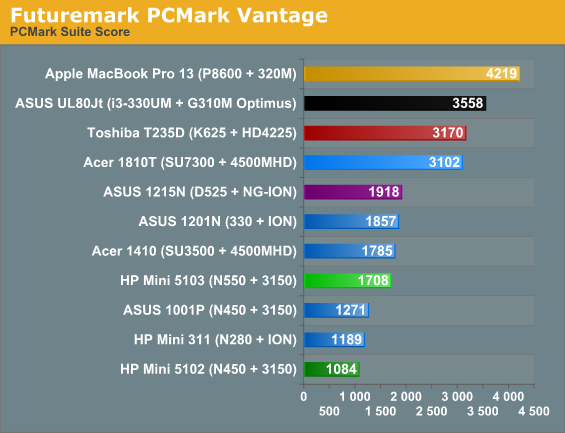
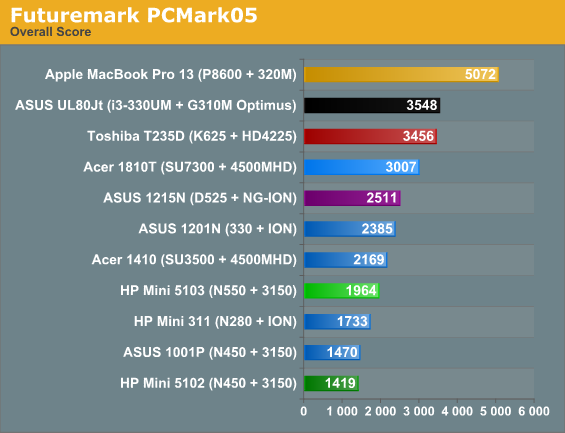
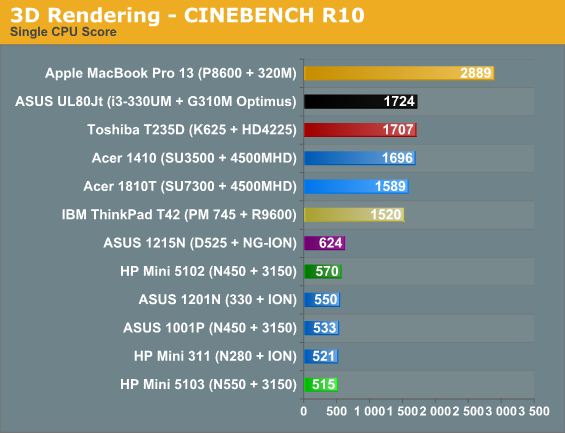
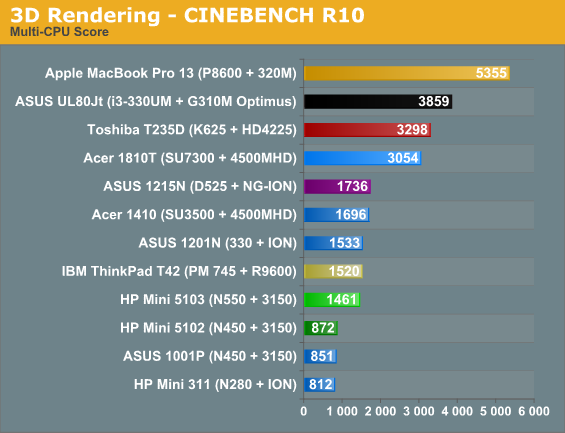
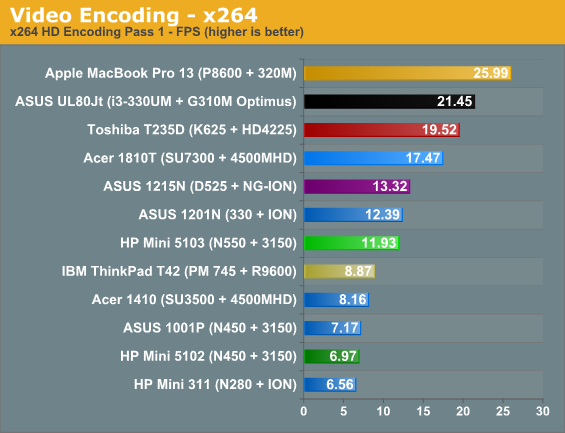
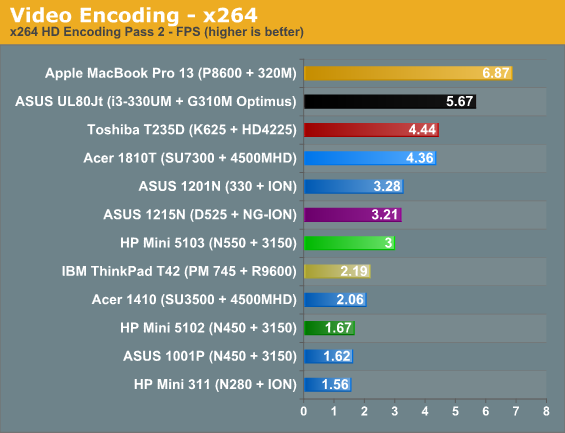
Our test suite tends to overemphasize multi-core processors, which means the dual-core N550 looks a lot better in the above charts than what you’ll experience in general. That’s why we include the single-threaded Cinebench result, because there are still plenty of times where that represents what you’d be doing with a PC, and in particular a netbook. The result is that there are times when the N550 is actually slower than single-core Atom CPUs, and there are other times where it can feel nearly twice as fast. PCMark Vantage ends up 58% faster than the 5102, PCMark05 is 38% faster, and our heavy-threaded testing is even better. Cinebench SMP is 68% faster, first-pass x264 encoding is 71% faster, and the second-pass x264 encode shows an 80% improvement. That’s the good news; the problem is single-threaded Cinebench is nearly 10% slower, and that does show up in general use.
I’ve used enough Atom netbooks to say that this is slightly faster overall, but it’s not a major performance increase. Instead, it’s a slight speed bump in most areas, and when you throw in results like that of an old 1.8GHz Pentium M 745 (i.e. the ThinkPad T42) there are a lot of applications where an old but fast single-core CPU still comes out on top. Windows 7 booted faster and was more responsive on a six-year-old T42 in practice, though like Atom netbooks it really struggles with fullscreen HD H.264 content (which is to say, it’s choppy and generally unwatchable). Unfortunately, I didn’t have enough time with the T42 to run PCMark, as I think the scores there would have shown more of what you see in the 1-CPU Cinebench test (perhaps not quite so dramatic, though).
You can also see a similar state of affairs when you look at performance results from the old CULV laptops like the Acer 1410 and 1810. The dual-core SU7300 completely eclipses the 5103, while the single-core SU3500 in the 1410 still beats the 5103 in every test other than x264 encoding. N550 does include support for SSE3, and that combined with Hyper-Threading gives it enough of a boost to come out on top in that particular test. Overall, however, the N550 can’t keep up. A more telling comparison is the Turion II K625, which boasts much higher overall performance for a lower price; if Brazos can offer a similar level of performance while cutting power requirements to Atom levels, the 2011 netbooks are going to be in for a nice upgrade at last.
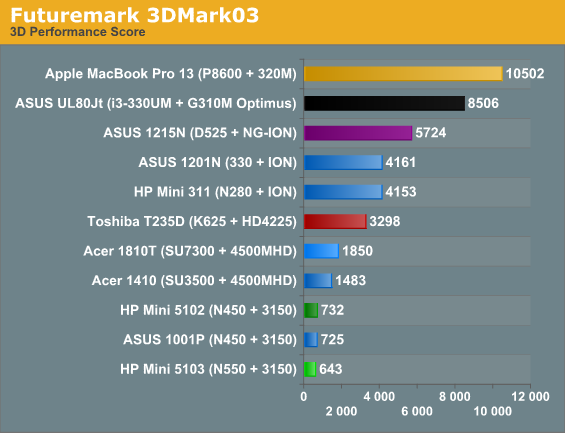
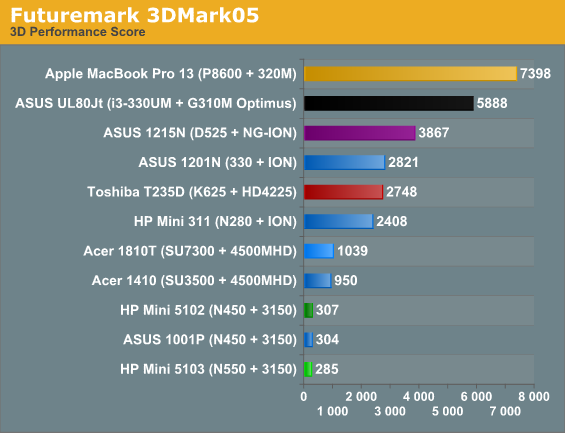
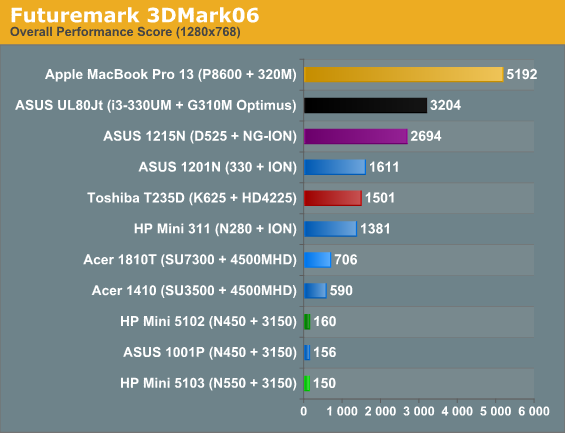
Atom on its own is unfit for most games released this side of 2000, so we didn’t bother with even trying to run any games. 3DMark tells the story well enough for our purposes: the HD 4225 in the Toshiba T235D is five to ten times faster than the anemic GMA 3150 IGP. We’ll have to wait for the next update to Atom to see if Intel is ready to put a bit more GPU performance into their inexpensive processor line. We’d expect they’re ready to make that move, considering AMD’s Brazos targets a similar market segment; if not, we may see a lot more netbook design wins from AMD in 2011.










57 Comments
View All Comments
seanleeforever - Monday, December 20, 2010 - link
your logic is flawed.instead of spending money on laptop/desktop/netbook and what have you, and only uses 1/4 of your investment every time, you could simply buy a ultra portable, and use your investment 100% of time. (not to mention the hassle of migrate files, sync folder and what not).
my x201 tablet weights about 3 lbs, 7 hr battery life, i7 core, ssd and IPS. small, light, portable (very portable because it is a tablet), and process 1080p flash and still have 60% of cpu power to do other stuff.
sure it is costly on the paper (about 10 time more expensive than my HP Mini 210), but i use it 100% of time.
synaesthetic - Monday, December 20, 2010 - link
I disagree with netbooks being portable. They're more portable, but when I had a netbook and a desktop compared to having just a full-size laptop, I used my netbook no more often than I use my laptop now. It was not any easier to quickly check something, because I still had to boot it... wait for the OS to start... be near a wifi connection... etc.My smartphone fills the portability niche.
LoneWolf15 - Monday, December 20, 2010 - link
I just got a Dell Latitude E4200 from their Outlet for $690 after tax. That includes the following:SU9600 processor
2GB RAM
12.1" 1200x800 matte display with full-size keyboard
64GB SSD and external eSATA DVD writer
Six-cell battery
The HP netbook is pretty cool if you want new, but I got a 3-year warranty with the Latitude, but when I can get a $1700 ultraportable as a certified-refurb for about the same as the HP, and it performs faster and has superior construction quality (not that the HP is bad, just the Latitude is killer), then the Latitude wins. I was also able to easily add a WWAN card after the fact.
Still, HP is moving in the right direction with this. I hope more vendors will do so.
Guspaz - Monday, December 20, 2010 - link
Atom has been on the market for almost three years now, and despite this fact, no significant advances have been made in power efficiency or performance.Compare the Atom 330, which came out in mid 2008 to the N550, reviewed today. Their power draw is about the same (8.5W versus 8W), and their performance and clockspeed is about the same (1.6GHz versus 1.5GHz).
Atom was underpowered when it was released, but fast enough to be useful. Today, performance is about the same, but the demands placed on it are higher. The end result is that Atom just gets worse and worse.
ULV products are a lot more interesting.
JarredWalton - Monday, December 20, 2010 - link
The only problem with your post is that the Atom 330 didn't have SpeedStep, it didn't have an IGP, and it didn't have DDR3 support. We looked at the ASUS 1201N way back in the day with Atom 330 + ION, and because of the lack of SpeedStep the battery life was about half of what you can now do with the N550. But the rest of what you say is true, and I really hope the next Atom revision does more to improve the status of netbooks.synaesthetic - Monday, December 20, 2010 - link
I'm afraid it won't, because Intel has already spent a great deal of time badmouthing netbooks as primary computing devices. They don't want netbooks to compete with their more expensive mobile processor lines. Hell, this is why they killed the SU2300 in the first place; because Acer was selling Aspire 1410s with that chip for $400 and it was selling like hotcakes, scarcely slower than the more expensive CULV chips!JarredWalton - Thursday, December 23, 2010 - link
I'm not so sure about your "simple math", rarson. The 5103 has a 29Wh battery, not a 66Wh battery (that upgrade is available, but it's not what I tested).Based on the figures in my review, at idle the Mini 5103 uses just 6.8W total. In the Internet test it uses 9.0W, and in the x264 test (the "worst case" scenario) it hits 12.9W. Of course, those are all on battery power, and I'd assume there's some inefficiency in getting power out of the battery and into the system.
As a secondary test, I just plugged the Mini 5103 into a Kill-A-Watt device to test power draw. Power adapter efficiency certainly comes into play in this test, and if it's 80% efficient (reasonable) the actual power draw is pretty close to the above calculations.
Idle: 10W
x264 playback: 13.5W
Cinebench SMP: 15W
So, again, TDP doesn't necessarily tell you a whole lot. Idle power requirements are much lower than TDP, and even heavy use will rarely hit TDP on everything, so you can't just add CPU, chipset, HDD, etc. TDPs to figure out how much power a system will actually use.